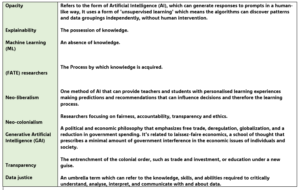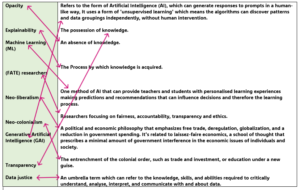Hello and welcome to this OER on Seeking Transparency in AI.
I would like to begin by introducing myself and the resource in the short video below.
An overview
The activities
There are six posts and 10 activities in total, each post should take approximately 30 minutes to read and engage with. It is recommended that you move through the six posts in numerical order 1-6. You can move between them by clicking on the arrows on the left of your screen or the links in the overview below or at the bottom of each post.
The focus is on Higher Education but many of the themes discussed may also be relevant to secondary and further education.
Below you can read a brief introduction to the topic and find a link to a Quizlet where you can review and test your knowledge of key terms and acronyms related to the topic.
Opacity
Higher Educational institutions do not have the resources required to look inside the ‘black box(es)’ of Artificial Intelligence (AI) nor is it possible to understand the complexities and unpredictability of the algorithms at work. In their journal article ‘Learning to work with the black box: Pedagogy for a world with artificial intelligence‘ Bearman & Ajjawi, (2023) propose pedagogic strategies that encourage students to engage with it critically, question whose interests are served and challenge unacceptable bias.
Below you can watch a short video clip of Dr Timnit Gebru from DAIR talk about data bias.
If technology cannot be neutral, then how does Dr Gebru suggest we deal with bias in AI?
Watch from 20.38-22.33 mins.
On What Matters want this video to be accessible to the widest possible audience.
How much do students know about data and whose responsibility is it to ensure they are equipped with the skills and understanding required, not just to navigate the digital world but to create one they desire?
Higher Education I suggest, has a responsibility to enact a digital ecosystem that is trustworthy, just and democratic in order to uphold the values they claim to operate by.
‘’honesty, trust, fairness, respect, and responsibility’’ (The University of Bristol, 2023).
Unless we are to assume that promotion of these values and principles are merely empty business rhetoric, HE institutions ought to be acting on them explicitly. Therefore, rather than merely accepting the status quo, educational institutions should work with students to make demands of Big Tech companies to be more open and transparent.
An Analogy
The ‘educator’ as a ‘lighthouse’ enabling the ‘student’ to find their way so they can safely reach their desired destination. But first we as educators need to know where the rocks that threaten to submerge the ship are hiding.

Lighthouse on top of a cliff overlooking the ocean.
All photos and videos on Pexels can be downloaded and used freely. Photo of lighthouse on top of a cliff
Key terms
Activity 1 Click on the link Quizlet key terms to access a set of topic related flashcards on Quizlet. You can test yourself, play a matching game or just take a look through the cards.


The featured images shows blurred lights in the dark, it represents the challenge of opacity in AI, that we cannot fully see or comprehend how it works.
Featured Image All photos and videos on Pexels can be downloaded and used freely. Blurred lights on a dark background
References
Bearman, M., & Ajjawi, R. (2023). Learning to work with the black box: Pedagogy for a world with artificial intelligence. British Journal of Educational Technology, [e-journal] 54 (5) pp.1160-1173 Available at: Learning to work with the black box: Pedagogy for a world with AI. (Accessed: 10 October 2023)
On What Matters (2023). How to make AI systems more just with Hilary Pennington and Dr. Timnit Gebru. Available at: How to make AI systems more just with Hilary Pennington and Dr.Timnit Gebru (Accessed 18 November).
University of Bristol (2023). Academic Integrity [online] Available at: Academic integrity | Current students | University of Bristol (Accessed 1 November).
You can now move onto section #2. The Black Box Debate which will discuss Opacity further 2. The Black Box Debate
Appendix
Matching exercise answers








